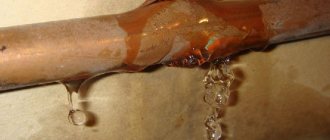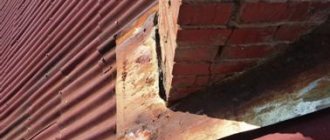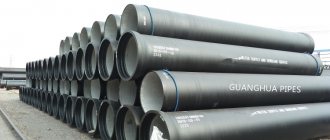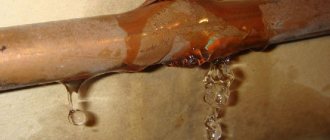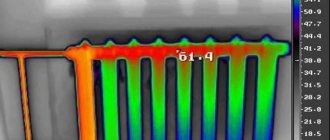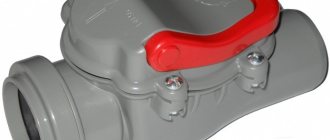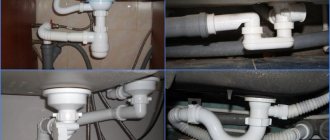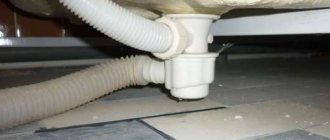In old multi-storey buildings, cast iron sewer pipes are laid. Over time, this material wears out. Holes or cracks appear in the pipes, which cause leaks. To solve this problem, you will have to resort to a thorough inspection of the sewer line and subsequent elimination of the defect.
Cast iron pipe repair
Repair of cast iron sewer pipe
If a cast iron pipe leaks in a toilet, repairs should be made immediately. This process depends on many factors, the main ones being:
- strength of the pipeline line;
- size of the defect;
- presence of longitudinal chips and cracks.
The following may indicate that a pipe has burst:
- the appearance of an unpleasant odor in the sewer system;
- presence of leaks on the outside and joints of pipes.
If a leak is detected at the entrance to the pipe (as a result of a poor-quality connection at the transition point of the siphon or drain hole), then the problem is solved by:
- gasket replacement;
- tightening connection elements;
- sealing the entrance structure.
How to repair a cast iron pipe when a leak is detected on the structure itself? In this case, you should carefully examine it to determine the size of the defect. If there are small holes or cracks in the pipe, then you do not need to dismantle it to carry out repairs. Otherwise, the damaged area will have to be removed.
Repair methods
There are many ways to repair a leaking sewer pipe, the choice of which depends on the location of the leak, the size of the hole or crack.
We recommend that you familiarize yourself with: Insertion and methods of connecting elements in the air duct
Plumbing specialists use several standard methods for sealing pipes when they leak:
- at the junction where there are threaded or flanged connections, a winding of flax strands is used, which are tightly compacted into the gap between the pipes and filled with a special solution;
- the resulting hole or crack in the body of the cast iron pipe is sealed using a rubber seal and a metal clamp;
- small holes and fistulas in the pipes are wrapped with a bandage pre-impregnated with epoxy resin;
- small cracks are sealed with a special quick-hardening sealant, then wrapped with reinforcing tape.
If it is quite simple to eliminate a leak at a pipe junction using a sealing material, then in a straight section where a crack or fistula has formed, it is necessary to properly prepare the pipe for repair.
Applying a clamp
The most reliable way to seal a pipeline if its integrity is damaged (crack or hole up to 2 cm) is to apply a special clamp.
To do this, the area of the future patch is cleaned with sandpaper or a special metal brush.
Next, the treated area is degreased using any solvent (acetone can be used).
The section of the damaged pipe is wrapped with a special rubber gasket or rubber bandage, onto which a metal clamp is placed.
The product is fixed very tightly with bolts and nuts. This method allows you to eliminate the leak and immediately return the pipeline to working condition.
Winding
Another proven method of sealing a leak is to wrap it with an epoxy-impregnated bandage. To do this, it is necessary to take the preparatory measures described above (cleaning and degreasing).
For wrapping, a regular gauze bandage is suitable, which must be dipped in a container with epoxy resin (sold in construction stores in the paint and varnish department). The pipe is wrapped in several layers and, if necessary, additionally secured with wire.
Repair using sealants
The use of liquid sealants is the third way to seal pipes in case of leakage. It is suitable for small holes and cracks up to 1 cm.
We recommend that you read: Installation of residential sewage systems - rules and possible errors
For this purpose, special semi-liquid polymer compositions are used, which are applied with a brush to a previously cleaned and degreased metal surface with a brush. The substance hardens upon contact with air and provides reliable sealing of the crack. But this method is only suitable for small longitudinal cracks.
Irregular holes larger than 1 cm cannot be sealed using sealants.
Important! Before patching a cast iron pipe, assess the overall condition of the pipeline. If the pipe is significantly outdated, covered with rust, and its internal clearance is greatly reduced due to deposits, it is more advisable to replace the entire pipeline with a new one using polypropylene or polyethylene pipes.
What to do if a leak occurs at the joints
Fixing a leak in a pipe joint is a relatively simple task. If all the pipeline elements in the area with the leak are not damaged, and the leak is caused by a leaky seal, you can use plumber’s flax and seal the joint yourself. To do this, you will need to prepare a solution of PVA glue, water and polycement in advance.
The algorithm of actions is as follows:
- The pipeline is blocked.
- The area of depressurization of the joint is dried using a rag and a hairdryer.
- Any sharp instrument can be used to remove any remaining cement binder.
- The linen winding is compacted using a hammer or other flat tool.
- The gap between two sections of the pipeline is filled with a prepared solution of PVA glue and polycement.
- The joint is additionally lubricated with a brush dipped in the resulting solution.
It is not recommended to use the sewer system within 24 hours after repairs.
Seal cracks or holes
To eliminate defects, different materials and technologies are used. You can seal a hole in the sewer using two universal fixing couplings UR-01. Their internal diameter must match the external dimensions of the pipe.
Using couplings does not require special tools:
- using a grinder, cut out the part of the pipe where the crack or hole appeared;
- Rust and dirt are removed from the ends of the pipes being connected, where the couplings will be located;
- the distance to the middle of the coupling is measured;
- marks are made at the ends of the pipes for the specified length;
- 2 couplings are installed on both ends of the pipe;
- a new piece of pipe is inserted (must have the same dimensions);
- the couplings move towards the new pipe (their ends are located at the level of the marks made);
- Use a wrench to tighten the bolts on the couplings.
You can also plug the hole using a simple rubber coupling with a seal. In this case, the joints must be covered with cement mortar and then painted.
In such a process as repairing a crack in a cast iron sewer pipe, it is not recommended to use improvised means. Chewing gum, plasticine, glue, and other household products will eliminate the problem only for a short time. The situation cannot be corrected by driving a wooden (plastic) chopper into the hole. This will cause even more damage to the system.
When carrying out repair work, it is prohibited to remove build-up on the pipe, as this will lead to the appearance of a new leak. A large number of rusty growths indicate that in the near future it is necessary to completely change this section of the sewer system.
Getting rid of fistulas
Before you fix a leak in a sewer pipe, you should understand how to fix it.
You can use the first method:
- wrap the damaged area with a rubber gasket;
- tighten with a clamp.
There is an alternative method:
- if a large fistula occurs, you will need to use a repair coupling;
- cut a piece of rubber to the size of the coupling;
- Tighten it well and the leak should stop.
It is worth noting that special plugs can be found on sale. They are installed in cleaning areas. You can additionally put a rubber gasket on the plug. The solution to sealing a cast iron sewer pipe if the leak continues is to additionally seal the plug with silicone.
If a leak has formed at a joint, then the joint is additionally filled with liquid glass, that is, silicate glue, on top of the sealing layer.
How to seal a cast iron pipe joint
Now let’s talk about how to cover the joints between adjacent pipes. The leak is eliminated as follows:
- the bell is hammered out;
- Remains of tow, cement and other debris are removed;
- all elements are dried with a hair dryer;
- a sanitary winding made from flax is stuffed into the gap;
- with an aqueous solution mixed with PVA glue and cement, it is necessary to waterproof the joint several times.
Sewer pipe repair can be carried out in different ways. Depending on the complexity of eliminating the defect, the following materials and tools are used:
- clamps;
- silicate glue;
- sandpaper;
- solvent;
- bandage;
- cement mortar;
- acetone;
- copper oxide;
- orthophosphoric acid;
- silicone sealant;
- self-adhesive tape;
- rags;
- metal brush;
- Screwdriver Set;
- container for cement mortar;
- mounting gun;
- synthetic brush;
- putty knife;
- construction hairdryer
Replacing a defective pipe
Often, due to serious damage, it is necessary to completely replace the entire pipe. To do this, you will need to stock up on tools and parts: a hacksaw for metal, flax, pipe wrenches, a sealant, a union nut and a coupling.
The sequence of work will be as follows:
- Using a metal hacksaw, the defective section of the pipe is cut out, plus 30 cm.
- We unscrew all the connections, clean the threads, and remove the cut piece of pipe.
- We make a new thread on the old pipe. To hold it, we use plumbing wrenches.
- We screw the coupling onto the pipe, after which we determine the length of the pipe to be replaced, taking into account the thread.
- We fix the pipe in a vice and cut off the required section.
- Using a die we cut a thread on it.
- We wrap flax around the thread and lubricate it with a sealant.
- Using a coupling, we connect the new piece of pipe to the old one.
- At the other end we join the new and old pipe with a union nut.
Repair using cement and construction adhesive
A crack that appears in a sewer pipe can be sealed. But for repair work, you cannot use a standard composition that does not have sufficient moisture-resistant properties. You should purchase silicate glue. It is resistant to the negative effects of a humid environment and promotes rapid setting of the cement mortar.
When eliminating a defect, the following must be taken into account. It is not recommended to mix glue and concrete mortar in a separate container. This will cause the mixture to harden prematurely and become unsuitable for effectively covering the crack. The solution is prepared directly on the damaged surface. For these purposes, use a synthetic brush.
Sewer pipe repair includes the following steps:
- the damaged area is cleaned with sandpaper (all rust must be removed);
- silicate glue is placed on the surface;
- dry cement is poured over the glue;
- the procedure is repeated 5-6 times.
How to get rid of unpleasant odor
A specific smell from the sewer system in the house can appear not only due to a leak, but also due to clogging and the formation of plugs from organic waste. It is also possible that there is a malfunction in the operation of the water seal - the siphon connecting the plumbing fixtures to the sewer pipe (although the siphon is designed specifically to protect against unpleasant odors of household wastewater).
We recommend that you familiarize yourself with: Insulation for protecting pipes, made of foamed polyethylene (thermal insulation)
Another reason for the appearance of an unpleasant odor is the process of depressurization of joints in the room, which may not be noticed if water is released drop by drop and flows through the pipes through a hole in the ceiling.
You can get rid of the smell by removing the blockage in the sewer, replacing the siphon connecting the sink in the bathroom, sink in the kitchen or bathtub in the bathroom with the sewer pipe.
If the fit of the pipe leading from the siphon to the tee is not tight enough, you must use a special sealant (sold in hardware stores).
If the integrity of the pipes and connections in the sewerage system is not compromised, but an unpleasant odor is present, it is necessary to clean the pipes using special strong reagents such as “Mole”, which dissolve plugs from organic residues.
If after use there is still an unpleasant odor, and the water from the drain drains more slowly or is retained, the help of a plumber is needed.
For cleaning, a specialist uses a flexible cable with a brush-type attachment, which he inserts through the drain into the sewer pipe and pushes the blockage mechanically.
Repair with cement and bandage
To eliminate a clearly visible hole, cement mortar and a bandage are used:
- the damaged part of the sewer system is cleaned with sandpaper and treated with a solvent;
- the bandage is cut into several pieces (each length is 0.4-0.5 m);
- a cement mortar is made, which should have a uniform consistency (you can use liquid glass instead of water);
- the bandage is dipped into the prepared solution;
- after soaking in the mixture, the bandage is wrapped around the damaged section of the pipe;
- a small amount of dry cement is poured on top of it (until a “cocoon” is formed);
- At the site of the crack, a layer of liquid glass is placed on the bandage.
The bandage is wrapped around the pipe 4-5 times. You can use the sewer system after a day, when the cement mixture is completely dry.
Repair with copper oxide and phosphoric acid
If there is significant damage to the riser or outlet pipe, when clamps, cement with a bandage or construction adhesive do not help, copper oxide and phosphoric acid are used. The undoubted advantage of this technology for eliminating the defect is the rapid solidification of the working mixture, which makes it possible to use the sewer 1-2 hours after the repair work.
Riser repair consists of four stages:
- Preparing the damaged area. Using a metal brush, the surface is cleaned of rust, and the crack deepens a little. This is done carefully, since cast iron can be damaged in other places.
- Degreasing the surface. Acetone is used to carry out this procedure.
- Preparation of repair solution. Phosphoric acid and copper oxide are mixed in a ratio of 1:1.5.
- Applying the working mixture. The solution is applied to the damaged area of the structure. This is done immediately after its preparation, otherwise the mixture will quickly harden and become unsuitable for repair work.
The application of the chemical is carried out wearing gloves and a protective mask. After using the solution, the room must be ventilated.
Application of cold welding
If the pipe is damaged in places where it is impossible to use a clamp or coupling, cold welding should be used. This technology involves mixing several substances without heating, when combined, chemical reactions occur with the subsequent formation of a working polymer mixture.
Cold welding consists of epoxy resin and filler (hardener). For this reason, the adhesive composition has:
- high adhesive qualities;
- plastic;
- quick hardening (the solution must be used immediately after preparation);
- excellent mechanical characteristics.
Sealing cracks and holes in the sewer system involves performing the following actions:
- cleaning the surface from rust and paint with sandpaper;
- preparing the working solution (you should get a homogeneous mass);
- applying the mixture with a spatula around the damaged area (the first layer is laid as carefully as possible);
- coating a crack or hole with a composition;
- grinding hardened material;
- degreasing the surface;
- applying a second layer of polymer substance.
If a leak appears in the damaged area, the plastic substance is rubbed in until it hardens. At the polymerization stage, the material is given the desired shape. This is done with a hand wearing a rubber glove.
To speed up the hardening process of cold welding, use a construction hair dryer (especially when repair work is carried out in the cold season). After using a hairdryer, the polymer is pressed onto the surface.
Most cold welding manufacturers produce two-component products. The first tube contains epoxy resin, which is mixed with a plasticizer and additional filler. The second tube contains a material that acts as a hardener. First, the contents of the first tube are applied to the damaged surface, and then the second.
The main advantage of cold welding is the ability to carry out quick repairs without shutting down the sewer system.
Silicone sealant
Sealing of joints and cracks in cast iron sewers is also carried out by other specialized means. These include silicone sealant, which is characterized by excellent adhesive properties regardless of the type of surface.
Silicone sealants are divided into:
- acidic;
- neutral.
The first products are not recommended to be applied to a surface that comes into contact with an aggressive environment. Neutral sealants are universal products.
Silicone sealant is applied to the damaged surface using a mounting gun. The vulcanization process is facilitated by moisture in the air. Silicone paste turns into a substance that has similar characteristics to rubber.
As alternative options for sealing cast iron pipes at home, the following are used:
- Portland cement;
- jute or hemp rope;
- epoxy resin;
- technical sulfur.
